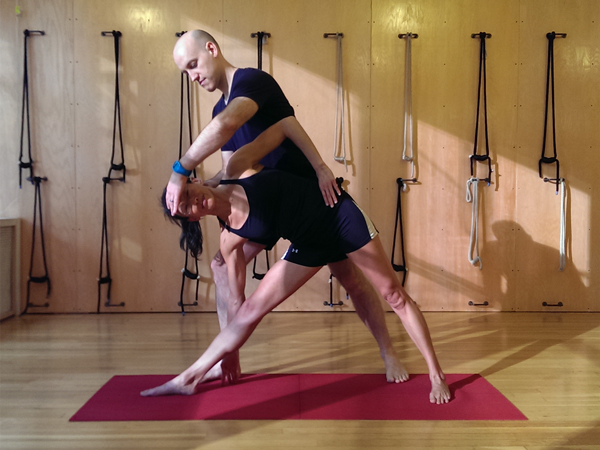 by Witold Fitz-Simon
Yoga teachers giving adjustments has become a controversial issue in the yoga community. Classic yoga adjustments tend to be strong, manipulative and often invasive, with the teacher sometimes applying considerable force to push a student deeper into a stretch, or to get the student’s arms and legs into a particular position. If such an adjustment is given skillfully, the effects can be positive. Often, however, teachers yank and crank on the student’s body in such a way that can potentially cause injury. It has gotten to point where some studios offer “consent cards” that students lay on their mats to let the teacher know whether or not they are willing to be manipulated in such a way. One company has even started marketing very attractive wooden chips that you can take with you to any studio to let the teacher know your preference.
by Witold Fitz-Simon
Yoga teachers giving adjustments has become a controversial issue in the yoga community. Classic yoga adjustments tend to be strong, manipulative and often invasive, with the teacher sometimes applying considerable force to push a student deeper into a stretch, or to get the student’s arms and legs into a particular position. If such an adjustment is given skillfully, the effects can be positive. Often, however, teachers yank and crank on the student’s body in such a way that can potentially cause injury. It has gotten to point where some studios offer “consent cards” that students lay on their mats to let the teacher know whether or not they are willing to be manipulated in such a way. One company has even started marketing very attractive wooden chips that you can take with you to any studio to let the teacher know your preference.
Injury in yoga—whether self- or teacher-inflicted—has become the current hot-button issue amongst those who love the practice. Even if the potential for injury were not in question, the way a teacher lays hands on a student can make a huge difference, for better and for worse. There a few different reasons why a teacher might give a student an adjustment. Amongst them are:
- To take a student deeper into a stretch (e.g.: pressing their back down in a forward bend)
- To arrange a body part to better fit an anatomical ideal (e.g.: outwardly rotating their upper arm bones and bringing their shoulder blades down their back)
- To help a student get closer to the classic shape of a pose (e.g.: bringing hands together to achieve binding of the arms in a twist)
Such adjustments come from a misplaced value system where the shape of the pose is more important than the experience of the body doing the pose, where more range of motion throughout the body is always better, where more extreme contortion is an indicator of progress along the path. In this way of thinking, the resistances of the body must be overcome by the force the teacher applies. The student’s body must be made to conform to an arbitrary geometry imposed on the student by the teacher’s eye. This is an unsubtle and forceful way of thinking that will not necessarily have the effect the teacher intended.
From the perspective of the Alexander Technique, the root cause of the problem comes from something called “End-Gaining.” This is a particular way of thinking—one of which we are all guilty—where we put the desired end or goal first and focus all our efforts on achieving this goal. The opposite of this would be one where we are attending more to the means whereby we achieve the goal. It is this “means-whereby” which becomes the important thing, regardless of whether the goal is ever achieved. In the Alexander Technique, this type of approach is called “Non-Doing."
Part of this “means-whereby” you might achieve something such as a yoga pose is an attention to the way the body is organized internally. F. M. Alexander, founder of the Technique, discovered that the relationship of the head, neck and back governs the functioning of the body as a whole for better or for worse. If that relationship is well-organized, we are stronger, more balanced and better integrated in the way we move. If it is not, we are weaker, stiffer, tighter.
The primary focus of a yoga teacher working with these principles becomes creating the best organization of the head, neck and back of the student in any given pose or transition. If the student can be more organized in this way, their bodies will be better able to negotiate the demands of a pose, creating balanced and functional strength and mobility. A teacher working in this way will not only be less likely to cause injury, they will be more likely to create conditions of lasting and significant change in their students.
This post originally appeared on Witold Fitz-Simon's blog.
[author] [author_image timthumb='on']http://www.acatnyc.org/main/wp-content/uploads/2014/01/After-crop1.jpg[/author_image] [author_info]WITOLD FITZ-SIMON has been a student of the Alexander Technique since 2007. He is certified to teach the Technique as a graduate of the American Center for the Alexander Technique’s 1,600-hour, three year training program. A student of yoga since 1993 and a teacher of yoga since 2000, Witold combines his extensive knowledge of the body and its use into intelligent and practical instruction designed to help his students free themselves of ineffective and damaging habits of body, mind and being. www.mindbodyandbeing.com[/author_info] [/author]
